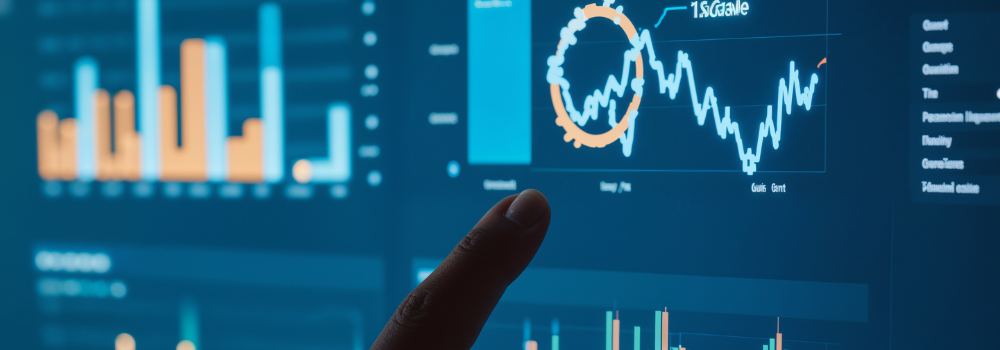From Data to Decisions: Spot Trends and Grow Faster with Visual Dashboards
Data visualizations empower home furnishings retail executives to unlock critical trends hidden within their business data. From tracking inventory flow to understanding customer preferences and sales patterns, visual dashboards simplify complex analytics, enabling smarter, faster decisions. We’ll reveal how visualization tools transform raw numbers into actionable insights that drive growth, profitability, and a competitive edge. Discover how you can use these tools to spot opportunities and elevate your business performance.
How Visual Dashboards Shape Insights
Presenting data as visuals, rather than reviewing it in raw formats, offers users an intuitive understanding of complex information. Visuals such as charts, graphs, and maps transform large datasets into easily digestible insights, enabling quicker pattern recognition and trend spotting. TechTarget adds that visualization tools make data more accessible and understandable so that non-technical users who aren’t data scientists can interpret and analyze it.
By automating the creation of visuals from source data, retailers save time and eliminate the need for manual data interpretation. Teams will value the focus on key metrics without having to sift through rows of numbers. Further, for many, visuals are more engaging and memorable, leading to a deeper grasp of data insights across teams.
Business intelligence dashboards streamline data visualization by presenting critical insights across various KPIs in the most effective formats. Instead of navigating multiple reports or spreadsheets, users can see performance metrics side-by-side, allowing them to quickly compare relationships and gauge progress across operational areas. With a dashboard, each KPI is displayed in a format that best communicates its story, ensuring clarity.

Why Spotting Trends is Critical for Furniture Retail Success
Trend-spotting is a powerful asset for executives. By identifying patterns, retailers can make informed decisions on purchasing, pricing, and marketing that align with long-term shifts in consumer behavior. Data visuals support efficient trend spotting, allowing teams to quickly identify emerging opportunities and address potential issues. For instance, spotting an increase in demand for eco-friendly furniture can inform product sourcing strategies, ensuring retailers stay ahead of customer expectations.
Types of Data Visuals and Their Uses in Trend Analysis
Business intelligence dashboards feature various kinds of data visualizations, each serving unique purposes in trend analysis:
- Cards: Highlight the immediate value of a key performance indicator (KPI), such as total sales,
conversion rate, or customer engagement. Cards provide a quick snapshot of critical metrics at a glance, helping executives focus on actionable data. - Gauges: Display real-time KPI values alongside performance indicators or target goals. Gauges are ideal for tracking metrics like revenue against monthly targets, ensuring teams stay aligned with business objectives.
- Line Charts: Ideal for tracking sales or foot traffic over time, line charts highlight long-term patterns and seasonal spikes. For instance, monitoring sales across quarters reveals peak shopping periods, enabling proactive inventory planning.
- Bar Charts: Useful for comparative insights, bar charts display sales by category, region, or demographic. Retailers can use bar charts to identify top-performing product categories or geographic regions, refining marketing and inventory allocation accordingly.
- Stacked Charts: Visualize part-to-whole relationships within a dataset, offering a clear comparison of segments. For example, stacked charts can illustrate how different product categories contribute to total monthly sales, helping retailers refine inventory and marketing strategies.
- Heat Maps: Heat maps help highlight high and low-performing segments within a dataset, such as identifying high-sales store locations or frequently purchased items. Retailers can leverage heat maps to visualize customer demographics across regions, aligning local inventory to match demand.
- Pie Charts: Representing data as proportions, pie charts clarify how different categories contribute to overall sales. For instance, analyzing product lines’ share of total revenue can guide stocking strategies, ensuring high-performing items receive priority.
- Scatter Plots: Scatter plots are excellent for identifying relationships between variables, such as pricing and sales volume. Retailers can use scatter plots to assess how discounts impact purchase frequency, refining pricing strategies to maximize revenue.
- Area Charts: Similar to line charts, area charts show trends over time but emphasize volume. For instance, an area chart can illustrate growth in online versus in-store sales, helping retailers allocate resources effectively to high-growth channels.
- Histograms: Histograms display the frequency distribution of data, such as the distribution of customer age groups or purchase amounts. Retailers can use histograms to understand customer demographics or average order values, tailoring promotions to target specific buyer segments.
- Geographic Maps: Geographic maps show sales or customer distribution by location, helping retailers see regional performance at a glance. Retailers can leverage these maps to optimize distribution center locations or localize marketing efforts based on geographic demand trends.
Each of these visualizations offers unique insights into retail performance, helping retailers make informed, data-driven decisions to enhance their strategies. These visuals make complex data approachable, assisting retailers in quickly understanding key metrics, identifying trends, and adjusting strategies based on visual evidence.
Customizing Dashboards for Impact
Customization makes dashboards relevant for different departments and business needs. Executives might require a high-level view, while inventory and marketing teams benefit from more granular data. For example, an inventory manager’s dashboard might prioritize stock turnover and reorder alerts, while a marketing team’s dashboard could spotlight demographic trends and seasonal sales peaks.
This flexibility allows each role to monitor relevant data, facilitating trend-spotting across various operational areas. By tailoring the focus of each dashboard, every team can zero in on the metrics that matter most to their role. This targeted approach eliminates distractions, allowing teams to identify actionable insights and make informed decisions quickly. Additionally, IBM notes the importance of data visualization in communicating insights interdepartmentally, stating it “helps teams and individuals convey data more effectively to colleagues and decision-makers.”

Combining Real-Time and Historical Data
A real-time visual dashboard provides an up-to-the-minute view of business operations, allowing teams to respond to changes as they happen. Whether monitoring inventory levels, tracking sales in progress, or assessing customer engagement, current data visualizations make it possible to act quickly, adapt to emerging trends, and address issues before they impact performance. This immediacy gives decision-makers a clear, actionable snapshot of operations, ensuring that adjustments can be made to keep everything on track, particularly during high-demand periods or promotional events.
On the other hand, visualizing historical performance data offers a valuable perspective on long-term trends and seasonal patterns, helping teams understand what strategies have been most effective over time. By comparing past performance with real-time data, retailers can anticipate demand, set realistic sales goals, and optimize inventory based on proven patterns.
Together, real-time and historical data visuals create a comprehensive framework that informs proactive decision-making. This allows businesses to make informed adjustments in the present while planning strategically for the future. For example, year-over-year sales comparisons can highlight emerging consumer preferences, enabling proactive decisions in product sourcing or promotional timing.
Embracing visual dashboards empowers retailers to move beyond raw data and focus instead on clear, actionable insights. By visualizing trends across product categories, customer segments, and sales channels, executives gain a comprehensive view of business performance, leading to data-informed decisions that drive sustained growth.
STORIS BI offers dynamic, real-time analytical dashboards designed to empower retail teams with customizable visuals tailored to their specific KPIs. By deploying these graphical insights across departments, your team gains the clarity and flexibility needed to drive strategic initiatives effectively. With STORIS BI, visualize data in a way that works for you and accelerates your path to data-driven decision-making.
Empower Your Team with the STORIS BI Suite
Sources
IBM. “Data Visualization.” IBM Think, 1 Nov. 2024, www.ibm.com/topics/data-visualization.
Hashemi-Pour, Cameron, et al. “What Is Data Visualization?” Search Business Analytics, 16 Aug. 2024, www.techtarget.com/searchbusinessanalytics/definition/data-visualization.
Frequently Asked Questions
What are the best types of visuals for tracking retail trends?
Line charts, bar charts, heat maps, and pie charts are among the most effective ways to visualize and track key retail metrics over time.
Dashboards aggregate data from multiple sources, making it easier to identify patterns in sales, inventory, and customer demographics that inform long-term strategies.
Yes, dashboards can be tailored to display specific metrics and visualizations suited to various departments and business objectives.
Trend-focused dashboards typically require data integration, visualization software, and periodic updates, depending on business needs.
Yes, visual dashboards can display both real-time metrics for immediate actions and historical data for long-term trend analysis.
